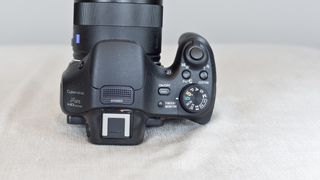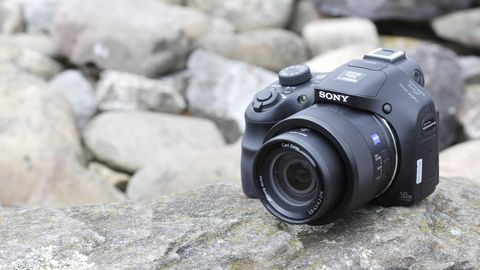Why you can trust TechRadar
We have come to expect great things from Sony cameras in the recent past, and while the HX300 offered a lot of good functions, we hoped that image quality would be improved for the HX400V.
With the addition of the Bionz X processor and a CMOS sensor, it would have been disappointing if there wasn't a notable improvement, so we're pleased to say that there is one. Images straight from the camera display bright, punchy colours that, while being accurate, are nicely saturated to give a pleasing effect.
The 20.4 million-pixel sensor is capable of resolving a lot of detail. If you look at an image at 100%, even at the lowest sensitivities, you will see some examples of image smoothing to produce a slight painterly effect.
This isn't particularly unusual for compact cameras (despite appearances, the HX400 still falls into this range) and the HX400 actually puts in a better performance than the HX60, which was announced at the same time and also features a 20.4 million-pixel sensor.

One of the biggest differences with this camera should be in low light performance, and the HX400V does well at high sensitivities. Looking at an image taken at a high sensitivity such as ISO 1600 reveals that at normal printing and web sizes (A3 or below) an overall impression of low noise and high detail is created.
If you examine at 100%, again you find examples of image smoothing, but noise is minimal. Noise reduction technology has done well, sometimes at the expense of detail, but unless you're printing at very large sizes this is unlikely to be a problem.
Activating Multi-Frame Noise Reduction means that the camera will take a few shots in very quick succession and combine them, taking areas of the photo with the least noise and putting them together for a cleaner image.
This works very well. It's worth remembering to switch it off when you're in a very well lit environment though, as waiting for the camera to process multiple files can take a while, and is generally only necessary in high sensitivity situations.
Metering system
Generally, the camera's metering system does a good job of producing accurate exposures. Having said that, occasionally we had to dial in a small amount of positive exposure compensation, especially in darker conditions.
This isn't particularly uncommon for cameras of this type though, and if you're using it in manual or semi-automatic mode, it's something you should be familiar with.
Similarly, the automatic white balance system does a great job of producing accurate colours. When faced with artificial lighting conditions, the camera errs ever so slightly towards warmer, orange tones, but if you find it problematic you could always switch to a more appropriate, specific white balance setting, such as incadescent.
With its huge zoom range, it's obviously important that the camera performs well at the far end of the telephoto optic. The camera's optical image stabilisation does a fantastic job of not only helping to keep shots blur-free, but also in keeping the shot steady while you're composing an image. This is especially useful if you're hand-holding the camera (it's assumed that the majority of holidaying photographers will be doing so).

If the 50x optical zoom isn't enough for you, you also have the choice of using Clear Image Zoom. This is Sony's brand of digital zoom, which similarly does an excellent job if you really need that reach. It's basically a crop of the image though, so it's also something you could achieve in post-production. Having a 20.4 million-pixel sensor means you can crop an image without losing too much resolution.
Autofocusing speeds are pretty decent with the HX400V, especially in good light. When heading indoors, or into a dimly lit area, speeds slow down a little, but are still pretty impressive, especially for a compact camera.
Strangely, although macro focusing is possible in automatic mode, there seems to be no way to activate macro focusing when shooting in manual or semi-automatic modes, which is a little frustrating when you want to fill the frame.
Slew of options
There are lots of options available on Sony cameras, which should appeal to those looking to get creative shots. Digital filters can be applied via the function menu when in manual and semi-automatic mode, and there are some fun options here.
Our favourites include Toy Camera and High Contrast Mono. It's a shame that the camera doesn't shoot a clean version of the image, in case you decide you don't like the filter at a later point. You can also change Picture Styles for a subtler effect, such as Monochrome, or Vivid.
Sony is a pioneer of Sweep Panorama technology, so it's no surprise to see that performing well here. It's very easy to use, and the resulting stitched image is excellent, with barely any example of blurring and a distinct lack of obvious clues that the images have been stitched together.
The HX400V's battery copes well and lasted a couple of days of reasonably intense shooting during tests. You can purchase an additional battery if you're worried about battery life, but it would be worth purchasing a charger too, since the battery charges in-camera.
Amy has been writing about cameras, photography and associated tech since 2009. Amy was once part of the photography testing team for Future Publishing working across TechRadar, Digital Camera, PhotoPlus, N Photo and Photography Week. For her photography, she has won awards and has been exhibited. She often partakes in unusual projects - including one intense year where she used a different camera every single day. Amy is currently the Features Editor at Amateur Photographer magazine, and in her increasingly little spare time works across a number of high-profile publications including Wired, Stuff, Digital Camera World, Expert Reviews, and just a little off-tangent, PetsRadar.

A key Apple app is rumored to be getting a major upgrade in macOS 15

Intel's formidable 288 core CPU now has a proper family name — Granite Rapids and Sierra Forest are Xeon 6 processors but is it just becoming too confusing?

Get six months of Disney+, Hulu, and ESPN+ free at Verizon with this epic deal

